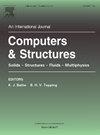基于多边形逆有限元法的壳体结构精确、灵活的形状感知
IF 4.4
2区 工程技术
Q1 COMPUTER SCIENCE, INTERDISCIPLINARY APPLICATIONS
引用次数: 0
摘要
基于三角形和四边形单元的反有限元法在复杂壳结构中由于收敛速度慢或网格质量差而面临重大挑战。为了提高复杂壳体结构形状感知的精度和灵活性,提出了一种变节点多边形有限元方法。采用张量分量混合插值法(MITC)和应变平滑元法(SSE)分别改善了剪切和膜的性能。此外,通过多边形光滑单元分析(SEA)方法和基于MITC的曲面壳单元iFEM范式,提高了低网格密度下形状感知的精度。最后,数值算例表明,该方法能够以较少的应变数据实现高精度的变形重构,支持灵活的网格细化和应变传感器部署,满足复杂形状和载荷条件下壳体结构的形状传感需求。本文章由计算机程序翻译,如有差异,请以英文原文为准。
Accurate and flexible shape sensing of shell structures with polygonal inverse finite element method
The inverse Finite Element Method (iFEM) based on triangular and quadrilateral elements faces significant challenges in complex shell structures due to slow convergence or poor mesh quality. In this study, a novel variable-node polygonal iFEM is developed to enhance the accuracy and flexibility of shape sensing for complex shell structures. Shear and membrane behaviors are respectively improved by the Mixed Interpolation of Tensorial Components (MITC) method and the Strain-Smoothed Element (SSE) method. Moreover, the precision of shape sensing at low mesh densities is improved through a polygonal Smoothing Element Analysis (SEA) method and an iFEM paradigm for curved shell elements based on MITC. Finally, numerical examples demonstrate that the polygonal iFEM achieves high-precision deformation reconstruction with less strain data, supports flexible mesh refinement and strain sensor deployment, and meets the shape sensing demands of shell structures with complex shapes and load conditions.
求助全文
通过发布文献求助,成功后即可免费获取论文全文。
去求助
来源期刊

Computers & Structures
工程技术-工程:土木
CiteScore
8.80
自引率
6.40%
发文量
122
审稿时长
33 days
期刊介绍:
Computers & Structures publishes advances in the development and use of computational methods for the solution of problems in engineering and the sciences. The range of appropriate contributions is wide, and includes papers on establishing appropriate mathematical models and their numerical solution in all areas of mechanics. The journal also includes articles that present a substantial review of a field in the topics of the journal.
 求助内容:
求助内容: 应助结果提醒方式:
应助结果提醒方式:


